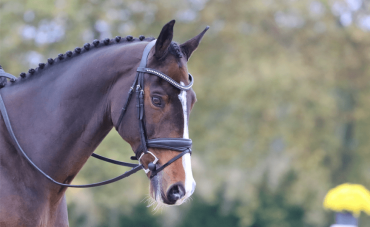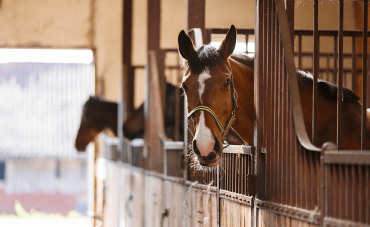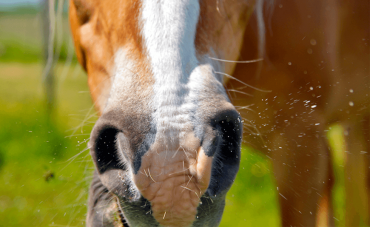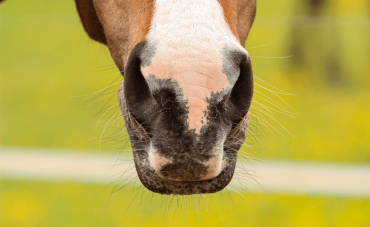How to build your horse's muscles?
Behind this question lies the idea of having a well-muscled horse that can execute the required exercises and perform.
When it comes to training, the discipline(s) you want to practice will determine the training. You are not going to ask a polo horse to have the same musculature as a showjumping horse. The demanded work on the muscles will be different for each discipline.
The real challenge is not about knowing how to train your horse but rather understanding why you need to train him. This is why it is essential for you to know which muscles your horse needs to develop to perform in his discipline. You will then have the keys to working "in the right direction".
How can your horse gain more muscle?
The key to allowing your horse to build muscle mass is progressive training. When working, the horse's muscles are stressed and contracted, resulting in small muscle cell injuries. When they heal (muscle remodeling), these cells will grow and/or multiply. The work also improves blood circulation in the muscles allowing a better oxygenation of the cells and a more efficient elimination of toxic waste for the muscle (lactate). As you can see, since the muscle cells need to "heal" after an effort, this process takes time. This is why it is necessary to take breaks during the work and to avoid intense back to back sessions, even if a regular training is important for the horse to get properly muscled.
As the healing process takes time, you must allow your horse to rest during your training sessions but also between sessions. Similarly, you will miss out on potential gains if you don't work the horses regularly enough. In addition to giving your horse's muscles sufficient ‘recovery’ time, you will need to take care of them. This means that they cannot be used suddenly without a proper warm-up or, conversely, they cannot stop being trained without consequences. Here are a few points to watch out for during your sessions:
- During the warm-up: the goal of the warm-up will be to prepare your horse's muscles to work. It is also useful to "relax" your horse which will prevent him from being too contracted. If a horse is warmed-up, then his muscles will be able to contract properly.
- During the session: as for the warm-up, loosening your horse remains a priority whatever the exercises. In addition, in order not to overstrain the muscles, especially with young inexperienced horses, don't forget to take walking breaks.
- At the end of the session: do not neglect the recovery which allows your horse to cool down and is essential for the good recovery of the body afterwards (limits the aches...).
In order for the muscles to be built, you will have to work them often so that they contract regularly. Some muscles are more difficult to strengthen and build than others, but don't forget that every movement causes muscles to act. Working on the 3 gaits already allows you to build up your horse's muscles.
Selecting the right exercises to strengthen your horse
As we said before, you will have to work your horse in coherence with its discipline. For example, learning the passage will not be helpful in developing your horse’s endurance.
Genetics also plays a major role in muscle development. You may know this already, but there are different types of muscle fibres which have different purposes:
- Type I fibres: these are the main fibres in endurance horse breeds. They enable long low-intensity efforts. This is explained by the way they function with oxygen, glucose and lipids.
- Type II fibres: these are the fibres for racehorses. They allow short and intense efforts. They work without oxygen but produce a lot of lactate.
You should therefore try to work on the muscle fibres best suited to your horse's discipline. Before tackling different types of "classic" exercises, there is one more point to address. Even if your favourite discipline is jumping, don't forget the importance of working on flat surfaces. To prepare your horse's muscles, but also its joints, to withstand the constraints of jumping. By preparing correctly, your horse will gain flexibility which will allow it to keep a healthy musculoskeletal system while building up muscles.
Here is a list of "classic" exercises to strengthen your horse's muscles. The list is of course not exhaustive!
The diverse terrain: the best gym in the world
The diverse terrain, with its alternating uphill and downhill sections, is great for building up your horse's muscles. Firstly for its morale, as these sessions often take place outdoors, you will be able to limit boredom. Then it will allow you to exercise your horse's muscles while limiting the impact on the joints, because generally the training is done at low speed.
If we analyse the impact of the " levels " of the varied terrain, the climbs will act more on the so-called superficial muscles which bring strength and power. They will also promote a certain tension in the back and a strong thrust in the hind legs. Conversely, downhill runs will work more on the deep muscles which have a direct impact on your horse's balance as well as its drive and straightness. They directly contribute to the strengthening of his abdominal strap by forcing him to support himself and engage the muscles well.
The reinback
Be careful, in order for the reinback to be considered as a weight training exercise, your horse must know how to do it correctly, in a relaxed and controlled way.
One of the big advantages of working the reinback will be the slow execution, which requires significant coordination. In addition to this, it is an exercise that works on the principle of fixed point inversion.
In anatomical terms, it is the ilio-psoas muscle (abdominal muscle which connects the lower parts of the lumbar vertebrae and the ilium with the upper part of the femur) which will work. When your horse walks forward, the fixed point of the ilio-psoas are the vertebrae and the ilium, it pulls its hind legs forward. When your horse moves backwards, it is the opposite! The fixed point is the femur, and the muscle will pull the body backwards. This movement is much more difficult.
To better understand why the inversion of the fixed point is more difficult, imagine you are lying on your stomach on your bed with your arms in the air and mimic the movement of the pumps with your arms. In this case, your body is the fixed point. Then do real push-ups, in which case your arms are the fixed point and the exercise is much more difficult. The reinback movement works on this principle.
The bounce
The bounce is a very good exercise to tone up your horse's abs (principle of close flexion-extension).
The principle of this exercise is the sequence of small jumps (at least two) very close together. So, as soon as your horse clears the first obstacle, it will immediately begin to jump the second. This implies that the front legs will take off again before the hind legs have even landed. There is therefore a phase between the two obstacles (the length depending on the speed of your horse) where the flexion of the back and the contraction of the abdominal muscles is very significant.
There are of course plenty of other exercises to strengthen your horse's muscles, such as walking in the water, neck extensions. You can also work on your horse on foot.
What is the key diet for good weight training?
We have repeatedly discussed your horse's nutrition. For any athlete, nutrition plays a major role in performance. Before going any further, we would like to remind you that as your horse is a herbivore, whatever its discipline, it must receive a sufficient supply of fodder (grass, hay, etc.)!
As we have seen, building up a horse's muscles requires "creating" new muscle cells, and for this you need an essential element: proteins. This is why you will have to pay attention to the quantity of proteins you bring but also to their quality.
Concretely, the quantity of protein corresponds to the MADC (Matières Azotés Digestible Cheval) and the quality can be evaluated thanks to Lysine which is an essential amino acid (not produced by the horse).
Muscles also need "fuel" to function and depending on the type of muscle fibres you need to adapt. For type I fibres (endurance), slow energy is needed, cellulose from fodder and lipids are good sources. For type II fibres (speed) you will need fast sugars such as starch...
If your feed is not rich enough in protein, or if it is a period when your horse needs to build up muscle, you can help him with feed supplements rich in essential amino acids (Myostem Mass).
To build up your horse's muscles, remember to keep an eye on it
As your horse is an athlete, in order to enable it to perform and achieve the best possible physical condition, it is essential to monitor it very regularly. Here are the most important points that we believe should be checked:
- Beware of muscular stiffness, although aches and pains are almost inevitable in the life of an athletic horse, more serious problems such as myositis must be identified and treated.
- Keep an eye on your horse's movement! Any changes in the joints or tendons (deformity, heat, inflammation) must be monitored. Do not hesitate to consult your vet if you have any doubts.
- The breathing of your horse is also essential! Poor breathing could lead to poor oxygenation of your horse, preventing it from performing well.
- It cannot be repeated often enough "no feet, no horse! "Remember to have your horse seen regularly by a farrier.
We're done with the horse's weight training for today. Of course everything we have presented here (and mainly the exercises) is dependent on your horse (breed, age, training level...). It is therefore important to set realistic goals for you and your horse. Please do not hesitate to surround yourself with professionals who can help you in your daily work with your horse. Ask your vet for advice, he or she will help you to keep your horse in good health.










